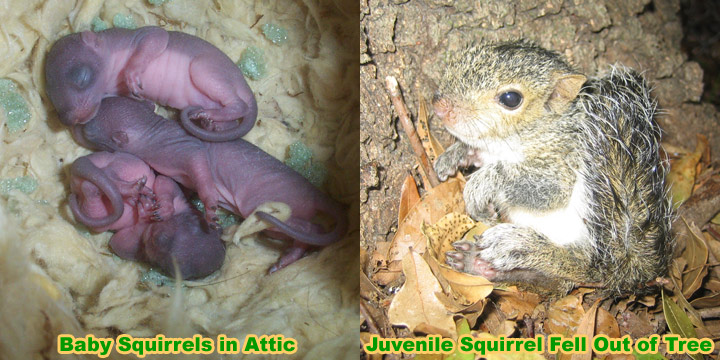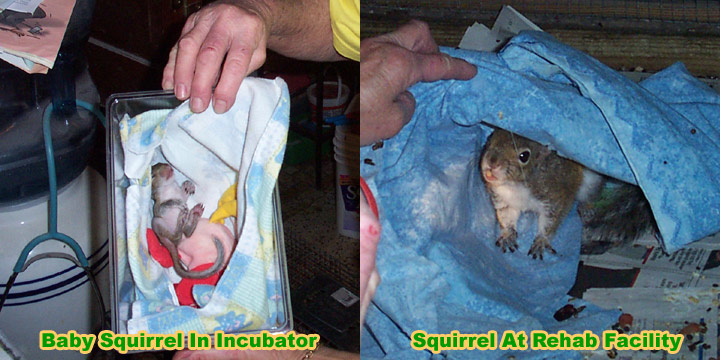|
|
What to do with a baby squirrel I found?
First, if the squirrel you found is an injured adult, it is not recommended that you attempt to touch the squirrel. Squirrels, even babies, will bite, and an adult will be more fearful of you if it is injured. Place a box with air holes over the adult squirrel until a wildlife rehabilitator can be called. Adult squirrels that are recuperated will not be domesticated, so please do not take an injured adult into your home thinking it will become your pet. In most states, it is actually illegal to keep any wild animal as a pet. You may protect the adult squirrel until a rehabilitator can come, but do not attempt any help beyond that.
If the squirrel you’ve found is a baby, first evaluate its condition. A sick or cold infant should be taken inside for care. Remember to always wear gloves when touching a wild animal. A host of ectoparasites and zoonotic diseases can be contracted if you are not careful. If the squirrel appears healthy, warm, and just out of place, it is always best to see if the mother squirrel will come for it. Protecting the baby (or babies) is important but always remember to allow a way for the mother squirrel to get to her infant. A source of warmth is equally important while you wait. A warm bottle of water or rice can be placed inside the protected area. A mother squirrel should return for her baby within two to three hours. If that span of time has passed, you can assume the mother will not be back. Adult squirrels do not move much at night due to predators, so if it is nearing dusk, place the babies inside and put them back out in the morning.
 To find a squirrel rehabber in your area, click on my nationwide directory of wildlife rehabbers or do an online search for one in your area. In the meantime, you can still care for the squirrel as advised below.
To find a squirrel rehabber in your area, click on my nationwide directory of wildlife rehabbers or do an online search for one in your area. In the meantime, you can still care for the squirrel as advised below.
Mom didn’t come back: If the mother squirrel hasn’t returned, you can take the baby squirrel inside. Using a well-padded box and a warm bottle or heating pad, keep the squirrel as isolated from the household as possible. Pets and children, noises, and bright lights will all be unnatural for the young tree-lover. Once the squirrel is warm, you can work on rehydrating it.
It is safe to assume that most orphaned animals have some degree of dehydration. This is the most common reason for a wildlife orphan to seem lethargic and sick. With a fine eye dropper, or a thin, oral feeding syringe, SLOWLY administer an electrolyte replacer such as Pedialyte. Hold the baby vertical. A young animal should never be on its back while feeding due to aspiration. Aspiration is a very serious concern with all infant animals. Forcing liquid into the mouth too quickly can result in that liquid entering the lungs. Liquid in the lungs can cause pneumonia and death. At this stage of the game, you should try to contact your local wildlife rehabilitator.
What the rehabilitator will do: Since you’ve taken extreme care and managed to rehydrate the baby squirrel, the wildlife rehabilitator will start the baby on a puppy milk replacement formula. If, for some reason, puppy milk replacer is not available, Ensure or another high-nutrient liquid diet can be substituted. Squirrels that are under six weeks of age will need to be fed every three hours. Squirrels between six to eight weeks of age will begin eating regular food, but will still need to receive formula three to four times daily.

A baby squirrel under five weeks of age will need to have manual stimulation of the “bathroom area”. This means, using a warm, wet towel or cloth, the rehabilitator will need to gently rub the genital area. This action is similar to a mother’s licking action out in nature. The sensation will teach the infant squirrel when it is necessary to relieve itself. Manual stimulation of the genitals is usually done after every feeding session.
Around ten weeks of age, the squirrel will be graduated from a diet of formula to a diet of shelled nuts, fruits, and certain vegetables. Ready-made diet packages are available for sale, but it is often not necessary to spend extra money on a commercial product. Most rehabilitators receive no outside funding, so on-site food preparation is one way for them to save money. If you have sent a squirrel out the door, consider purchasing some supplies to help the rehabilitator. Most of these folks do not require payment or donations, but any help is certainly appreciated.
Squirrels can be released back into the wild only after weeks of adaptation between a cage life and freedom. A rehabilitator will go to great lengths to insure a hand-raised squirrel knows how to find food, find shelter, and escape from predators. Even with careful schooling, hand-raised squirrels are at a disadvantage. It will take lots of time and effort to increase the chance of survival.
Here are some other advice articles for wildlife rehabilitation:
What to do with a baby bat I found?
What to do with a baby deer I found?
What to do with a baby fox I found?
What to do with a baby opossum I found?
What to do with a baby raccoon I found?
What to do with a baby hawk or eagle I found?
What to do with a baby reptile I found?
What to do with a baby mouse or rat I found?
What to do with a baby songbird I found?
What to do with a baby squirrel I found?
|
|
 |
Please be kind to wildlife! Our wild animals are intelligent, and believe it or not, they definitely have emotions! |
 |
|
|
|